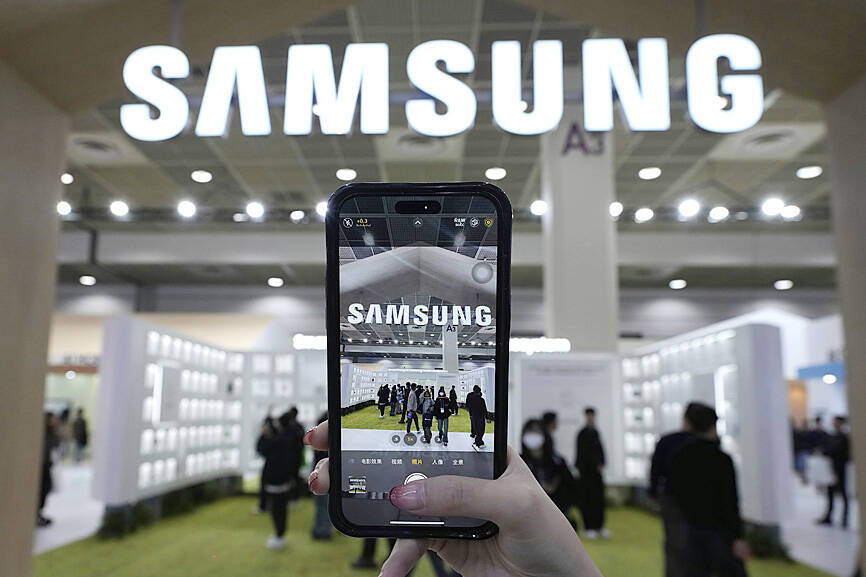South Korea yesterday announced plans to invest almost US$5 billion extra in the country’s semiconductor industry, citing “growing uncertainty” over US tariffs.
The country is a major exporter to the US and its powerhouse chip and auto industries would suffer a hefty hit from US President Donald Trump’s threatened 25 percent levies.
Concerns about the sector have hammered the Seoul-listed shares of the world’s largest memory chip maker Samsung, and largest memory chip supplier SK Hynix.

Photo: AP
Officials have now stepped up to provide more cover for the economically crucial industry by announcing that an extra US$4.9 billion would be pumped into it through next year.
“An aggressive fiscal investment plan has been devised to help local firms navigate mounting challenges in the global semiconductor race,” the South Korean Ministry of Finance said in a press release.
It warned that “growing uncertainty” following rounds of US tariff threats had left the sector clamoring for government support.
“To foster a dynamic, private sector-led ecosystem for semiconductor innovation and growth, the government will increase its investment in the sector from 26 trillion won (US$18.2 billion) to 33 trillion won,” the ministry said.
Trump announced on his April 2 “Liberation Day” sweeping tariffs on its global trading partners, including the 25 percent on South Korean goods, before backtracking and suspending their implementation for 90 days.
Even so, “duties targeting specific sectors such as semiconductors and pharmaceuticals, remain on the horizon,” South Korean Minister of Finance Choi Sang-mok said during a meeting.
“This grace period offers a crucial window to strengthen the competitiveness of South Korean companies amid intensifying global trade tensions,” he added.
“The government plans to expand support for the semiconductor industry, allocating 33 trillion won, with over 4 trillion won in fiscal spending set to be injected through 2026,” he said.
The package includes funding for infrastructure development, including underground transmission lines at semiconductor clusters that are currently being built.
“The government will boldly support investment by semiconductor companies,” Choi said, adding that the package included securing talent for the industry.
The investment is part of a large revised supplementary budget proposal of 12 trillion won and requires the approval of the National Assembly.
The tariffs announcement has rocked global markets, with investors uncertain over whether they are a negotiating tactic or permanent US position.
Trump has insisted he would not back down until he has reduced or even wiped out US trade deficits — while simultaneously signalling that he is ready to negotiate.
The US trade deficit with South Korea was US$66 billion in goods last year.
Seoul last week unveiled a US$2 billion emergency support package to help automakers weather the storm.
Still, analysts said that for now, South Korea should not be too worried about its chip sector. “Unlike automobiles, which are already subject to tariffs, semiconductors are unique in that the United States lacks viable substitutes,” Sejong University professor Kim Dae-jong said.
“Our companies are building large-scale semiconductor plants in the US, contributing to local job creation, a point that will likely be emphasized,” Kim added. “Behind-the-scenes negotiations will likely continue, and there is a chance they could conclude on a positive note. There also remains the possibility that tariffs will be adjusted item by item in the future.”

US sports leagues rushed to get in on the multi-billion US dollar bonanza of legalized betting, but the arrest of an National Basketball Association (NBA) coach and player in two sprawling US federal investigations show the potential cost of partnering with the gambling industry. Portland Trail Blazers coach Chauncey Billups, a former Detroit Pistons star and an NBA Hall of Famer, was arrested for his alleged role in rigged illegal poker games that prosecutors say were tied to Mafia crime families. Miami Heat guard Terry Rozier was charged with manipulating his play for the benefit of bettors and former NBA player and

The DBS Foundation yesterday announced the launch of two flagship programs, “Silver Motion” and “Happier Caregiver, Healthier Seniors,” in partnership with CCILU Ltd, Hondao Senior Citizens’ Welfare Foundation and the Garden of Hope Foundation to help Taiwan face the challenges of a rapidly aging population. The foundation said it would invest S$4.91 million (US$3.8 million) over three years to foster inclusion and resilience in an aging society. “Aging may bring challenges, but it also brings opportunities. With many Asian markets rapidly becoming super-aged, the DBS Foundation is working with a regional ecosystem of like-minded partners across the private, public and people sectors

BREAKTHROUGH TECH: Powertech expects its fan-out PLP system to become mainstream, saying it can offer three-times greater production throughput Chip packaging service provider Powertech Technology Inc (力成科技) plans to more than double its capital expenditures next year to more than NT$40 billion (US$1.31 billion) as demand for its new panel-level packaging (PLP) technology, primarily used in chips for artificial intelligence (AI) applications, has greatly exceeded what it can supply. A significant portion of the budget, about US$1 billion, would be earmarked for fan-out PLP technology, Powertech told investors yesterday. Its heavy investment in fan-out PLP technology over the past 10 years is expected to bear fruit in 2027 after the technology enters volume production, it said, adding that the tech would

YEAR-END BOOST: The holiday shopping season in the US and Europe, combined with rising demand for AI applications, is expected to drive exports to a new high, the NDC said Taiwan’s business climate monitor improved last month, transitioning from steady growth for the first time in five months, as robust global demand for artificial intelligence (AI) products and new iPhone shipments boosted exports and corporate sales, the National Development Council (NDC) said yesterday. The council uses a five-color system to measure the nation’s economic state, with “green” indicating steady growth, “red” suggesting a boom and “blue” reflecting a recession. “Yellow-red” and “yellow-blue” suggest a transition to a stronger or weaker condition. The total score of the monitor’s composite index rose to 35 points from a revised 31 in August, ending a four-month